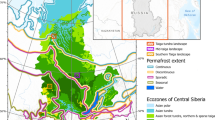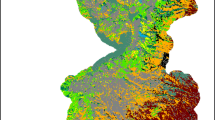Abstract
Understory fire modeling is a key tool to investigate the cornerstone concept of landscape ecology, i.e. how ecological processes relate to landscape structure and dynamics. Within this context, we developed FISC—a model that simulates fire ignition and spread and its effects on the forest carbon balance. FISC is dynamically coupled to a land-use change model to simulate fire regimes on the Amazonian landscapes of the Xingu Headwaters under deforestation, climate change, and land-use management scenarios. FISC incorporates a stochastic cellular automata approach to simulate fire spread across agricultural and forested lands. CARLUC, nested in FISC, simulates fuel dynamics, forest regrowth, and carbon emissions. Simulations of fire regimes under modeled scenarios revealed that the major current and future driver of understory fires is forest fragmentation rather than climate change. Fire intensity proved closely related to the landscape structure of the remaining forest. While climate change may increase the percentage of forest burned outside protected areas by 30% over the next four decades, deforestation alone may double it. Nevertheless, a scenario of forest recovery and better land-use management would abate fire intensity by 18% even in the face of climate change. Over this time period, the total carbon balance of the Xingu’s forests varies from an average net sink of 1.6 ton ha−1 year−1 in the absence of climate change, fire and deforestation to a source of −0.1 ton ha−1 year−1 in a scenario that incorporates these three processes.






Similar content being viewed by others
References
Alencar A, Solorzano LA, Nepstad DC (2004) Modeling forest understory fires in an eastern Amazonian landscape. Ecol Appl 14(4):S139–S149
Alencar A, Nepstad DC, Vera Diaz MDC (2006) Forest understory fire in the Brazilian Amazon in ENSO and non ENSO years: area burned and committed carbon emissions. Earth Interact 10:1–16
Alencar A, Asner GP, Knapp D, Zarin D (2011) Temporal variability of forest fires in eastern Amazonia. Ecol Appl 21(7):2397–2412
Almeida CM, Gleriani JM, Castejon EF, Soares-Filho BS (2008) Neural networks and cellular automata for modeling intra-urban land use dynamics. Int J Geogr Inf Sci 22(9):943–963
Aragão LEOC, Shimabokuro YE (2010) The incidence of fire in Amazonian forests with implications for REDD. Science 328:1275–1278
Balch JK, Nepstad DC, Brando PM, Curran LM, Portela O, Carvalho O Jr, Lefebvre P (2008) Negative fire feedback in a transitional forest of Southeastern Amazonia. Glob Change Biol 14:1–12
Barlow J, Peres CA (2008) Fire-mediated dieback and compositional cascade in an Amazonian forest. Philos Trans R Soc B 363(1498):1787–1794
Betts RA, Cox PM, Collins M, Harris PP, Huntingford C, Jones CD (2004) The role of ecosystem-atmosphere interactions in simulated Amazon forest dieback under global climate warming. Theor Appl Climatol 78:157–175
Cardoso MF, Hurtt CG, Moore (2003) Projecting future fire activity in Amazonia. Glob Change Biol 9:656–669
Carmenta R, Parry L, Blackburn A, Vermeylen S, Barlow J (2011) Understanding human-fire interactions in tropical forest regions: a case for interdisciplinary research across the natural and social sciences. Ecol Soc 16(1):53
Cochrane MA (2003) Fire science for rainforests. Nature 421:913–919
Cochrane MA, Barber CP (2009) Climate change, human land use and future fire in the Amazon. Glob Change Biol 15:601–612
Cochrane MA, Alencar A, Shulze MD, Souza CM Jr, Nepstad DC, Lefebvre P, Davidson EA (1999) Positive feedbacks in the fire dynamic of closed canopy tropical forests. Science 284:1832–1835
Collins M, The CMIP Modelling Groups: BMRC (Australia), CCC (Canada), CCSR/NIES (Japan), CERFACS (France), CSIRO (Austraila), MPI (Germany), GFDL (USA), GISS (USA), IAP (China), INM (Russia), LMD (France), MRI (Japan), NCAR (USA), NRL (USA), Hadley Centre (UK), YNU (South Korea) (2005) El Niño- or La Niña-like climate change? Clim Dyn 24:89–104
Cox PM, Betts RA, Bunton CB, Essery RLH, Rowntree PR, Smith J (1999) The impact of new land surface physics on the GCMsimulation of climate and sensitivity. Clim Dyn 15:183–203
Cox PM, Betts RA, Collins M, Harris PP, Huntingford C, Jones CD (2004) Amazonian forest dieback under climate-carbon cycle projections for the 21st century. Theor Appl Climatol 78(1–3):137–156
Cox PM, Harris PH, Huntingford C, Betts RA, Collins M, Jones CD, Jupp TE, Marengo JA, Nobre CA (2008) Increasing risk of Amazonian drought due to decreasing aerosol pollution. Nature 453:212–216
Cushman SA, McGarigal K, Neel MC (2008) Parsimony in landscape metrics: strength, universality, and consistency. Ecol Indic 8:691–703
Fearnside PM (1997) Greenhouse gases emissions from deforestation in Amazonia: net committed emissions. Clim Change 35:321–360
Forman RTT, Godron M (1986) Landscape ecology. Wiley, New York
Green DG (1983) Shapes of simulated fires in discrete fuels. Ecol Model 20:21–32
Hirsch AI, Little WS, Houghton RA, Scott NA, White JD (2004) The net carbon flux due to deforestation and forest regrowth in the Brazilian Amazon: analysis using a process-based model. Glob Change Biol 10:908–924
Houghton RA, Skole DL, Nobre CA, Hackler JL, Lawrence KT, Chomentowski WH (2000) Annual fluxes of carbon from deforestation and regrowth in the Brazilian Amazon. Nature 403:301–304
IPCC (2007) Climate change 2007: The Physical Science Basis. Contribution of Working Group I to the Fourth Assessment Report of the Intergovernmental Panel on Climate Change. Cambridge University Press, Cambridge
Johnstone J, Rupp T, Olson M, Verblya D (2011) Modeling impacts of fire severity on successional trajectories and future fire behavior in Alaskan boreal forests. Landscape Ecol 26:487–500
Kapos V, Ganade G, Matsui E (1993) d13C as an indicator of edge effects in tropical rainforest reserves. J Ecol 81:425–431
Malhi YJ, Aragão LEOC, Galbraith D, Huntingford C, Fisherd R, Zelazowski P, Sitche S, McSweeneya C, Meirb P (2009) Exploring the likelihood and mechanism of a climate-change-induced dieback of the Amazon rainforest. Proc Natl Acad Sci USA 106:20610–20615
Marengo JA, Nobre CA, Tomasela J, Oyama MD, Oliveira GS, Oliveira R, Camargo H, Alves LM, Brown IF (2008) The drought of Amazonia in 2005. J Clim 21:495–516
Melillo JM, McGuire DA, Kicklighter DW, Moore B III, Vorosmarty CJ, Schloss AL (1993) Global climate change and terrestrial net primary production. Nature 363:234–240
Nepstad DC, Verissimo A, Alencar A, Nobre C, Lima E, Lefebvre P, Shlesinger P, Potterk C, Moutinho P, Mendoza E, Cochrane M, Brooksk V (1999) Large-scale impoverishment of Amazonian forests by logging and fire. Nature 398:505–508
Nepstad DC, Lefebvre P, Silva UL, Tomasella J, Schlesinger P, Solórzano L, Moutinho P, Ray D, Benito JG (2004) Amazon drought and its implications for forest flammability and tree growth: a basin wide analysis. Glob Change Biol 10:1–14
Nepstad DC, Shwartzman S, Bamberger B, Santilli M, Ray D, Schlesinger P, Lefebvre P, Alencar A, Prinz E, Fiske G, Rolla A (2006) Inhibition of Amazon deforestation and fire by parks and indigeous Lands. Conserv Biol 20:65–73
Nepstad DC, Stickler C, Soares Filho BS, Merry F (2008) Interactions among Amazon land use, forests, and climate: prospects for a near-term forest tipping point. Philos Trans R Soc B 363(1498):1737–1746
Nepstad D, Soares-Filho BS, Merry F, Lima A, Moutinho P, Carter J, Bowman M, Cattaneo A, Rodrigues H, Schwartzman S, McGrath DG, Stickler CM, Lubowski R, Piris-Cabezas P, Rivero S, Alencar A, Almeida O, Stella O (2009) The end of deforestation in the Brazilian Amazon. Science 326:1350–1351
Oyama MD, Nobre CA (2003) A new climate-vegetation equilibrium state for Tropical South America. Geophys Res Lett 30(23):2199. doi:10.1029/2003GL018600.2003
Phillips OL, Aragão LEOC, Lewis SL, Fisher JB, Lloyd J, López-González G, Malhi Y, Monteagudo A, Peacock J, Quesada CA, Heijden G, Almeida S, Amaral I, Arroyo L, Aymard G, Baker TR, Bánki O, Blanc L, Bonal D, Brando P, Chave J, Oliveira ACA, Cardozo ND, Czimczik CI, Feldpausch TR, Freitas MA, Gloor E, Higuchi N, Jiménez E, Lloyd G, Meir P, Mendoza C, Morel A, Neill DA, Nepstad D, Patiño S, Peñuela MC, Prieto A, Ramírez F, Schwarz M, Silva J, Silveira M, Thomas AS, Steege H, Stropp J, Vásquez R, Zelazowski P, Dávila EA, Andelman S, Andrade A, Chao KJ, Erwin T, Di Fiore A, Honorio E, Keeling H, Killeen TJ, Laurance WF, Cruz AP, Pitman NCA, Vargas PN, Ramírez-Ângulo H, Rudas A, Salamão R, Silva N, Terborgh J, Torres-Lezama A (2009) Drought sensitivity of the Amazon rainforest. Science 323:1345–1347
Phulpin T, Lavenu F, Bellan MF, Mougenot B, Blasco F (2002) Using SPOT-4 HRVIR and vegetation sensors to assess impact of tropical forest fires in Roraima, Brazil. Int J Remote Sens 23:1943–1966
Ramming A, Jupp T, Thonicke K, Tietjen B, Heinke J, Ostberg S, Lucht W, Cramer W, Cox P (2010) Estimating the risk of Amazonian forest dieback. New Phytol 87(3):694–706
Ray D, Nepstad D, Moutinho P (2005) Micrometeorological and canopy controls of fire susceptibility in forested Amazon landscape. Ecol Appl 15:1664–1678
Saatchi SS, Houghton RA, Alvalá RCS, Soares JV, Yu Y (2007) Distribution of aboveground live biomass in the Amazon Basin. Glob Change Biol 13:816–837
Sampaio G, Nobre C, Costa MH, Satyamurty P, Soares-Filho BS, Cardoso M (2007) Regional climate change over eastern Amazonia caused by pasture and soybean cropland expansion. Geophys Res Lett 34(17):L17709. doi:10.1029/2007GL030612
Santos SNM, Costa MH (2004) A simple tropical ecosystem model of carbon, water and energy fluxes. Ecol Model 176:291–312
Silvestrini RA, Soares-Filho BS, Nepstad D, Coe M, Rodrigues HO, Assunção R (2011) Simulating fire regimes in the Amazon in response to climate change and deforestation. Ecol Appl 21(5):1573–1590
Sismanoglu RA, Setzer AW (2005) Risco de fogo da vegetação na América do Sul: comparação de três versões na estiagem de 2004. Paper presented at the XII Simpósio Brasileiro de Sensoriamento Remoto, Goiania, Brazil, 16–21 Apr 2005
Soares Filho BS, Pennachin CL, Cerqueira G (2002) DINAMICA—a stochastic cellular automata model designed to simulate the landscape dynamics in an Amazonian colonization frontier. Ecol Model 154(3):217–235
Soares-Filho BS, Nepstad DC, Curran LM, Cerqueira GC, Garcia RA, Ramos CA, Voll E, McDonald A, Lefebvre P, Schlesinger P (2006) Modelling conservation in the Amazon basin. Nature 440(7083):520–523
Soares-Filho BS, Rodrigues HO, Costa WL (2010a) Modeling environmental dynamics with dinamica EGO. Centro de Sensoriamento Remoto, Belo Horizonte, Brazil. http://www.csr.ufmg.br/dinamica. Accessed May 2010
Soares-Filho BS, Moutinho P, Nepstad D, Anderson A, Rodrigues H, Garcia R, Dietzsch L, Merry F, Bowman M, Hissa L, Silvestrini R, Maretti C (2010b) Role of Brazilian Amazon protected areas in climate change mitigation. Proc Natl Acad Sci USA 107(24):10821–10826
Stickler CM, Nepstad DC, Coe MT, Mcgrath DG, Rodrigues HO, Walker WS, Soares-Filho BS, Davidson EA (2009) The potential ecological costs and co-benefits of REDD: a critical review and case study from the Amazon region. Glob Change Biol 15:2803–2824
Turner MG, Romme WH (1994) Landscape dynamics in crown fire ecosystems. Landscape Ecol 9:59–77
Van der Werf GR, Morton DC, DeFries RS, Giglio L, Randerson JT, Collatz GJ, Kasibhatla PS (2009) Estimates of fire emissions from an active deforestation region in the southern Amazon based on satellite data and biogeochemical modelling. Biogeosciences 6:235–249
World Bank (2010) Assessment of the risk of Amazon dieback Main Report. World Bank, Climate Change and Clean Energy Initiative, Environmentally and Socially Sustainable Development Department, Latin America and Caribbean Region. http://www.bicusa.org/en/Document.101982.aspx. Accessed October 2011
Acknowledgments
We thank the Gordon and Betty Moore Foundation, the David and Lucille Packard Foundation, Conselho Nacional de Desenvolvimento Científico e Tecnológico, and the Large-Scale Biosphere Atmosphere Experiment for funding. Special thanks go to Jennifer Balch and the field team.
Author information
Authors and Affiliations
Corresponding author
Electronic supplementary material
Below is the link to the electronic supplementary material.
Rights and permissions
About this article
Cite this article
Soares-Filho, B., Silvestrini, R., Nepstad, D. et al. Forest fragmentation, climate change and understory fire regimes on the Amazonian landscapes of the Xingu headwaters. Landscape Ecol 27, 585–598 (2012). https://doi.org/10.1007/s10980-012-9723-6
Received:
Accepted:
Published:
Issue Date:
DOI: https://doi.org/10.1007/s10980-012-9723-6




